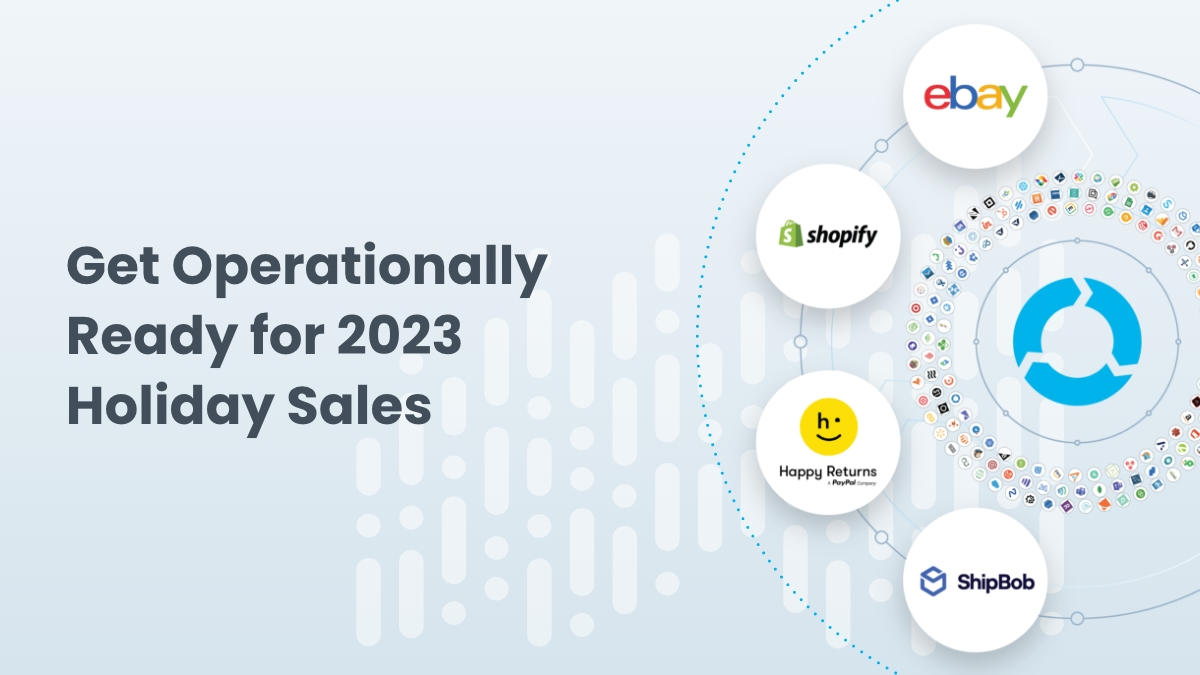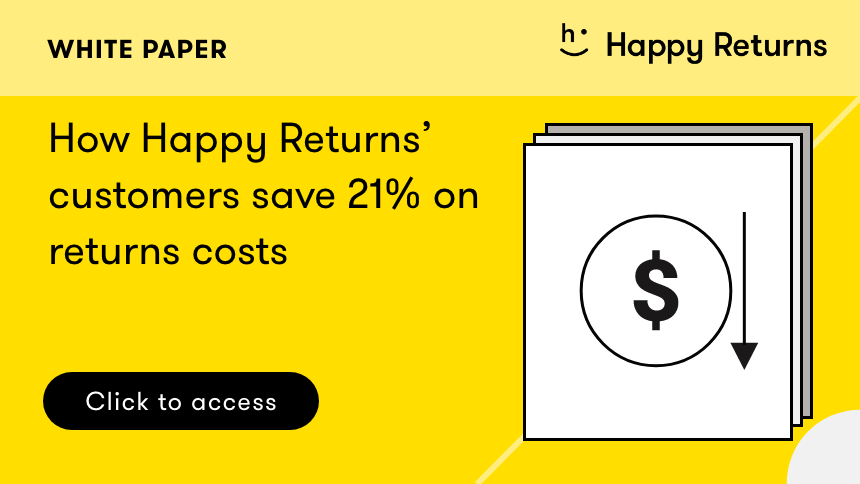Get operationally ready for the holidays
Ebru Saglam, Celigo's Principal Product Marketing Manager, spoke with industry leaders to discuss how merchants can best prepare for the upcoming holiday shopping season. The panel discussion included four participants:
Sanaz Hajizadeh, Director of Product for Happy Returns
Kohl Perkins, Head of Business Development, eBay
Emma Irvine, Retail Acquisition & Former Merchant, Shopify
Kevin Marvinac, VP of Partnerships, ShipBob
This blog compiles key takeaways and quotes from the panel. If you’re interested in watching or listening to the full panel, you can find it here:
Key Takeaways:
Return rates continue to rise, but the right return policy can help increase sales conversions and incentivize desirable behaviors
Accurate data is key during peak sales seasons, especially regarding available inventory
Merchants are focusing on excellent service, notably a strong post-consumer experience
What can we expect for the holiday season this year? Are there any changes in market dynamics with respect to previous years, and do you see any emerging trends influencing shopper behavior?
Emma Irvine
People are just not buying in the same way. Things like buy now, pay later solutions are going to be key around the holiday season. Matching customers with where they are and how they can buy is going to be huge from an economic perspective.
Other than that, I think that having buy online pick up in store (BOPIS) options are going to be super important, having the ability to be on your couch at home, glass of wine in your hand, and pick up that item the next day on your way home from work.
Kohl Perkins
There's a shift in what people are buying today versus what they bought two to three years ago at the height of the pandemic, where we had economic stimulus flowing into a lot of people's pockets, a lot of higher [average sales price] ASP items were flying off the shelves. Today people are making decisions around what's best for their family and buying the right things.
As a brand or as a manufacturer, I would rethink what I'm promoting and how I'm promoting it in certain categories. A lot of people are going to be a little bit tighter in what they spend and how much they spend in the holiday season.
Sanaz Hajizadeh
You have to manage your demand and supply chain, but post-purchase and returns also.
With all the uncertainty and the trends that we are seeing on the demand side, one thing is clear: returns are still happening, especially as people are more cautious about where they're spending their money.
84% of merchants told us that their return rates have increased or stayed flat.¹
70% of merchants said that they they're seeing an increase in bracketing, and bracketing is when people are buying multiple, different colors and sizes of the same items to choose one, which adds to the increased return rate.²
“One thing is clear: returns are still happening, especially as people are more cautious about where they're spending their money.” - Sanaz Hajizadeh
Especially in peak sales seasons like the holidays, merchants are looking to take a more holistic approach to stand out from their competition. Before, all the investment was in selling through the storefront, investing in marketplaces. Now, they're looking to enable shoppers across storefronts, marketplaces, and physical stores.
Giving them alternative payment options like buy now, pay later (BNPL) definitely is one way to accelerate the sales conversion. But what we also see is the goal is no longer just to complete the sale, but also to differentiate.
There's a shift where merchants are now looking to improve the whole shopper journey by providing exceptional experiences right after sales for fulfillment, returns, and across all the different channels.
“There's a shift where merchants are now looking to improve the whole shopper journey by providing exceptional experiences right after sales for fulfillment, returns, and across all the different channels.” - Sanaz Hajizadeh
What's the importance of offering different returns options?
Merchants are trying to stand out by offering free shipping for returns, but it gets to be a burden to manage and restock the return inventory and free shipping lowers profits. What's the importance of offering these different returns options and what are common mistakes you see here?
Sanaz Hajizadeh
I see a lot of merchants thinking that if they make returns harder, then their return rate will become lower. If I make my customer jump through hoops, and have to email and talk to people and do all of these things, then they won't return anything.
But what you’re actually doing is you're annoying your customer. Now instead of focusing on selling, and finishing that abandoned checkout, and reaching out to the customer to finish the sale, they leave all these [shoppers] in limbo… And overall, you may lose a loyal customer.
“I see a lot of merchants thinking that if they make returns harder, then their return rate will become lower... but what you’re actually doing is you're annoying your customer.” - Sanaz Hajizadeh
One of our customers is Cariuma. And the moment Cariuma enabled Happy Returns with in-person drop-off options, they increased the lifetime value of their customers by 20% — it was just so easy that the customers grew to trust the brand.
Merchants have two very powerful tools in their hand. One is their return policy, and one is return options.
Having a good return policy, you can encourage [and incentivize] the preferred behavior that you want to see. Instead of having the return being a cost center, instead of a customer returning and getting a refund, you can offer the customer an exchange or store credit.
If you bought this item for $100, instead of getting $100 back, you can shop for $110 worth. The constant there becomes revenue retained, because when they go back to shop, they’re likely shopping for more than $110.
“Merchants have two very powerful tools in their hand. One is their return policy, and one is return options. Having a good return policy, you can encourage [and incentivize] the preferred behavior that you want to see.” -Sanaz Hajizadeh
The other part is return options [with] easy solutions. We know that customers are checking your return policy before checking out. One of the reasons they have abandoned checkout is because they don't like your policy. Having return options, being up front with the customer showing them how easy it is, also helps with your sales.
The mail-only return is expensive. Shipping individual packages is expensive and there is no economy of scale. On your operations side, people have to open these packages one by one, figure things out, especially during holiday season. Automating helps you reduce your cost of shipment and cost of returns, and [speeds up] your whole process.
“Mail-only return is expensive. Shipping individual packages is expensive and there is no economy of scale.” -Sanaz Hajizadeh
What are the right systems and processes that need to be implemented, automated and enhanced ahead of the holidays to achieve operational readiness
Emma Irvine
Increasing your inventory slowly, keeping in mind that spending power is lower than previous due to inflation and maybe a recession, focusing on items that are going to be in demand and selling those at a steady increased rate, is going to be a huge tool in your toolbox.
Data is king. If you have the data to support the products that are going to be the highest sellers, that's where you're going to increase your inventory and you want to avoid having a surplus of inventory in those areas.
“Data is king. If you have the data to support the products that are going to be the highest sellers, that's where you're going to increase your inventory.”
Kohl Perkins
I think automation is key, but not everything fits all sizes. The best advice that I can give to the sellers on this call – brands, manufacturers, whatever size is to take a step back and identify where you spend your time… look at your day to day. Where am I spending the most time? How can I create efficiencies in what I'm doing and what tools are accessible for me?
I always challenge my teams to take a different look, look from the side angle or the top. Are we doing everything that we can and as a business, where are we spending time? Am I fully automated? Do I have the right data and have I looked from the right angle at my products and processes to make sure that I’m fully ready to move into the holiday season?
Sanaz Hajizadeh
I want to double down on product description, pictures, videos, product reviews. Those are the tools that you have up front to be able to manage the shopping experience of your shoppers.
But on the return side, #1 you have your return policy: a clear, concise, and obvious general policy – especially during holiday season. If you have a different return policy for holidays and then normal items if they are final sale because they're discounted, [or] if you have a different policy for gift returns—don't forget that a lot of things that people buy during this time are not for themselves, they're gifting it—those [policies] need to be clear.
86% of shoppers check return policies before shopping³, so if they're confused, they will not check out. Those are the tools that you have upfront to manage and reduce your returns.
But you want to make sure you have a return partner who works with your fulfillment center, is very healthy, and can automate the data and verify your inventory is right.
“86% of shoppers check return policies before shopping, so if they're confused, they will not check out.”³ -Sanaz Hajizadeh
You need to have a clear understanding of what shipments are coming back to your warehouse, especially during holiday season, again, operations is going to focus on fulfilling the orders and shipping them to get there on time and they don't have time to deal with all these [returns].
Last but not least, let’s not forget customer service. There are two questions that people call them for, Where is my order? And Where is my refund?
If you provide a Happy Returns in-person drop off, the refund gets initiated immediately. So that second question gets eliminated from your customer service completely.
“There are two questions that people call [customer service] for: Where is my order? And Where is my refund?” -Sanaz Hajizadeh
Kevin Marvinac
Yeah, that's a great point.
You can't wait around 5 to 7 business days for the package to get to the warehouse and then another couple days for it to be inspected and see the disposition return before you initiate the refund – that's not the world we live in. Let's be honest, we are in an Amazon world now and the refund should come sooner than that.
We have to think beyond the old experience of let's wait till we physically get the return and then we'll make the customer jump through a lot of hoops to actually get the refund.
Sources:
Worldwide Business Research (WBR), commissioned by PayPal, December 8, 2022 - January 17, 2023. The phone interview was conducted by WBR across 100 U.S. apparel and footwear merchants with annual revenues of $500 million or more (n=100).
Worldwide Business Research (WBR), commissioned by PayPal, December 8, 2022 - January 17, 2023. The phone interview was conducted by WBR across 100 U.S. apparel and footwear merchants with annual revenues of $500 million or more (n=100).
TRC, commissioned by PayPal, September 8-19, 2022. The research was conducted by TRC, with fieldwork administered by Forsta across 2,002 U.S. consumers who returned an online purchase within the past year. (n=2,002)








